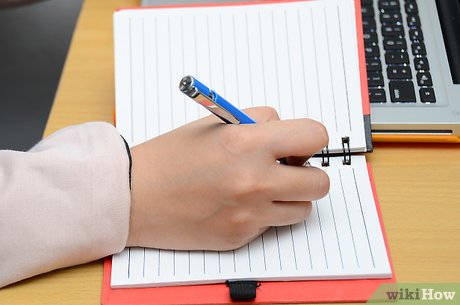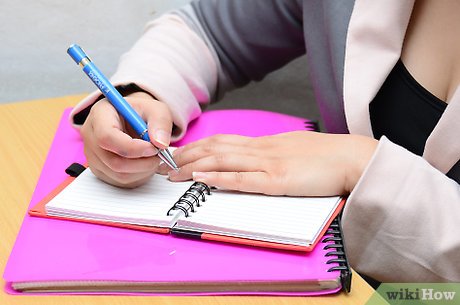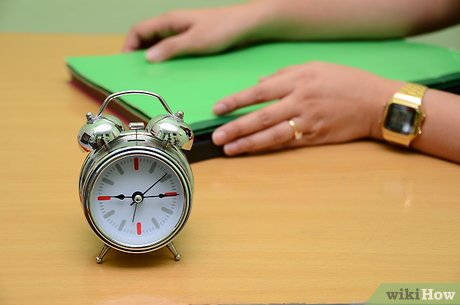How to Lecture Well
Method 1 of 3:
Lecture Preparation
-
 Choose a few main points for your lecture. Your audience will learn more effectively if the information presented is organized around key themes, allowing them to relate smaller details to bigger ideas.
Choose a few main points for your lecture. Your audience will learn more effectively if the information presented is organized around key themes, allowing them to relate smaller details to bigger ideas.- These themes should represent the main educational content of the lecture: what you want the audience to learn in addition to whatever smaller details you provide.
-
 Generate examples that demonstrate these key points to facilitate the audience's retention.
Generate examples that demonstrate these key points to facilitate the audience's retention.- These might be passages from a text, historical examples, selected data from a report, etc. Choose examples which you can explain fully in a few minutes and which will help your audience to grasp the subject matter.
-
 Decide on a conclusion that you want your audience to draw from your lecture.
Decide on a conclusion that you want your audience to draw from your lecture.- In contrast to the 1 to 3 key points, this will be a question that you want your listeners to consider further, a problem for further analysis, or a thesis or proof that explains the information you have given earlier. Such a conclusion will help your audience retain the other details you include in your lecture.
-
 Prepare an introduction to the material that you have prepared. Consider something that will grab the audience's attention, such as an anecdote or surprising fact.
Prepare an introduction to the material that you have prepared. Consider something that will grab the audience's attention, such as an anecdote or surprising fact. -
 Design an outline or lecture notes that cover your lecture material. These will allow you to organize your thoughts in a coherent manner that will be easier to listen to than a scattering of thoughts.
Design an outline or lecture notes that cover your lecture material. These will allow you to organize your thoughts in a coherent manner that will be easier to listen to than a scattering of thoughts.- Do not write out your lecture, as this will lead you to read from your notes and have poor delivery; instead, provide general topic headings and a few key details or sentences that you want to include.
- You should be able to speak freely off of this outline without pausing to review your notes. If there are specific facts you want your audience to retain, be sure to highlight these.
-
 Eliminate 10 to 20 percent of the material you have prepared thus far understanding that you will not be able to cover everything you want.
Eliminate 10 to 20 percent of the material you have prepared thus far understanding that you will not be able to cover everything you want. -
 Prepare any visual or audio aids that will help the audience grasp your lecture material.
Prepare any visual or audio aids that will help the audience grasp your lecture material.- Examples might include a slideshow, props, a sample of music, or a few images displayed on a board or screen.
-
 Visit the space in which you will be lecturing well in advance of the lecture. Make note of whiteboards, lighting, and other tools so that you do not seem unprepared or flustered when your lecture begins.
Visit the space in which you will be lecturing well in advance of the lecture. Make note of whiteboards, lighting, and other tools so that you do not seem unprepared or flustered when your lecture begins. -
 Rehearse your lecture. Speak more slowly than you think you need to and aim to finish at least a few minutes before the lecture is scheduled to end so that your lecture can survive delays and distractions.
Rehearse your lecture. Speak more slowly than you think you need to and aim to finish at least a few minutes before the lecture is scheduled to end so that your lecture can survive delays and distractions.
Method 2 of 3:
Beginning the Lecture
-
 Begin your lecture with the introduction you have prepared to grab your audience's attention.
Begin your lecture with the introduction you have prepared to grab your audience's attention. -
 Move quickly from your anecdote or surprising fact to a summary of the information you are going to present so that your audience, while engaged, begins to learn immediately.
Move quickly from your anecdote or surprising fact to a summary of the information you are going to present so that your audience, while engaged, begins to learn immediately.- Be sure to mention what the audience should retain from the lecture: either a few broad themes or a collection of facts and ideas.
- Make sure that audience members have time to take notes if they wish. Do not pause for more than several seconds at a time and leave short pauses after major points.
-
 Continue speaking at a regular, easy-to-follow pace. Exercise control over the audience in the form of speaking continually and demanding constant attention to help listeners focus.
Continue speaking at a regular, easy-to-follow pace. Exercise control over the audience in the form of speaking continually and demanding constant attention to help listeners focus.
Method 3 of 3:
Ensuring Audience Engagement and Retention
-
 Make eye contact with all parts of the audience and use your hands for extra emphasis. This will keep the audience's attention on you.
Make eye contact with all parts of the audience and use your hands for extra emphasis. This will keep the audience's attention on you. -
 Walk around in front of the audience, not staying anchored to your lecture notes. The more an audience is encouraged to pay attention to movement and change, the less likely they are to sit back and be passive.
Walk around in front of the audience, not staying anchored to your lecture notes. The more an audience is encouraged to pay attention to movement and change, the less likely they are to sit back and be passive. -
 Repeat and emphasize your major points to ensure that the audience grasps and remembers them.
Repeat and emphasize your major points to ensure that the audience grasps and remembers them. -
 Restate all key facts, especially numbers and dates. Watch to make sure that audience members have time to copy this information down.
Restate all key facts, especially numbers and dates. Watch to make sure that audience members have time to copy this information down. -
 Relate your material to any visual aids you have prepared or previous material which has been discussed in the course or other lectures.
Relate your material to any visual aids you have prepared or previous material which has been discussed in the course or other lectures.- It will be easier for the audience to remember the content of the lecture if it is related to as many other sources as possible.
-
 Close by reviewing once again the lecture material you have presented and sending the audience away with a key message around which they can organize their thoughts.
Close by reviewing once again the lecture material you have presented and sending the audience away with a key message around which they can organize their thoughts. -
 Leave time for questions, either in front of the audience or after people have dispersed.
Leave time for questions, either in front of the audience or after people have dispersed.
4 ★ | 1 Vote
You should read it
- How to Conduct Audience Analysis
- Discover the 'unbeatable' 2D material: Light as plastic and stiffer than steel
- How to activate Material Design interface on YouTube
- Google updates the Material guide for programmers
- Scientists create the world's best heat-resistant material, which can be used for spacecraft
- MIT makes a material that keeps it cool without electricity



















 How to Get an Undergraduate Research Position
How to Get an Undergraduate Research Position How to Be an Etymologist
How to Be an Etymologist How to Become a Paraprofessional
How to Become a Paraprofessional How to Become a Psychology Professor
How to Become a Psychology Professor How to Become a College Professor
How to Become a College Professor How to Become a School Principal
How to Become a School Principal